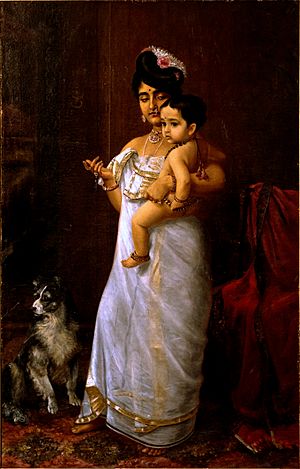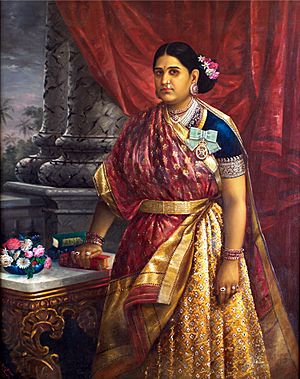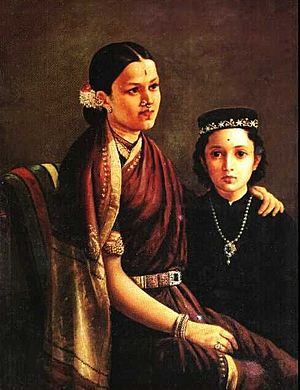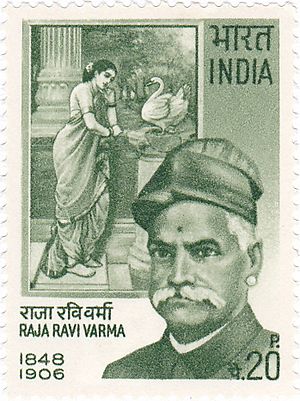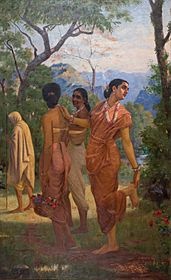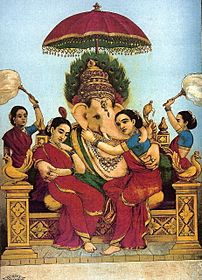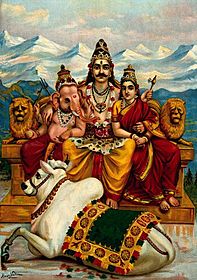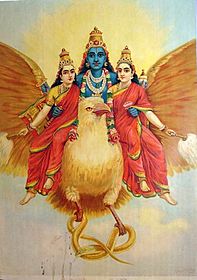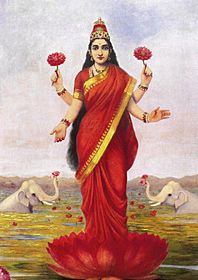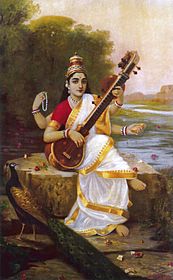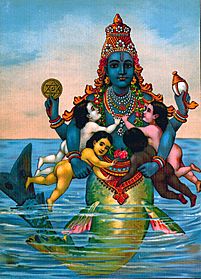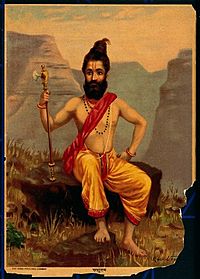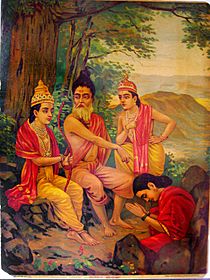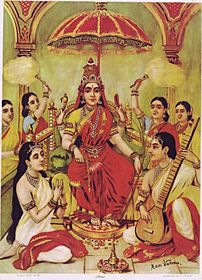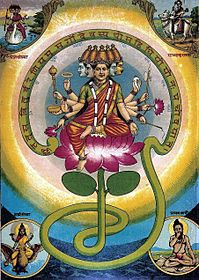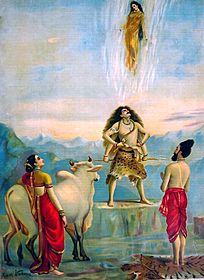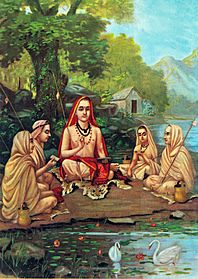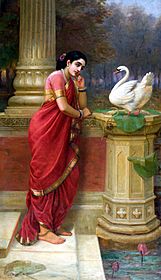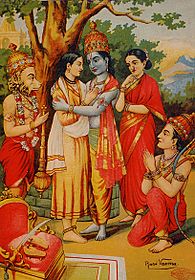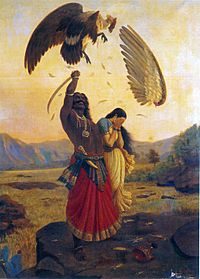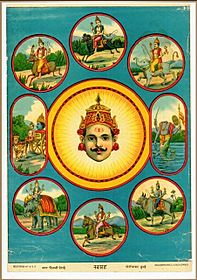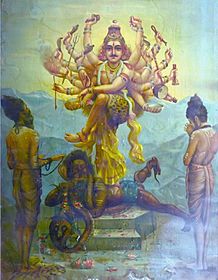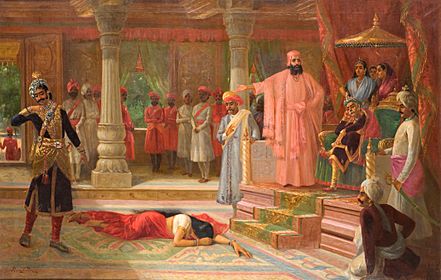Raja Ravi Varma facts for kids
Quick facts for kids
Raja Ravi Varma
|
|
|---|---|
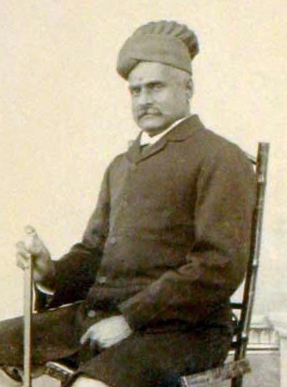
Raja Ravi Varma in 1890s
|
|
| Born | 29 April 1848 |
| Died | 2 October 1906 (aged 58) Attingal, Travancore
|
| Other names | Koil Thampuran of Kilimanoor, Ravi Varma Koil Thampuran |
| Alma mater | University College Thiruvananthapuram |
| Occupation | painter, artist |
|
Notable work
|
|
| Spouse(s) | Pooruruttathi Thirunal Mahaprabha Thampuratty |
| Awards | Kaisar-i-Hind Gold Medal |
| Signature | |
 |
|
Raja Ravi Varma (born April 29, 1848 – died October 2, 1906) was a famous Indian painter and artist. Many people think he was one of the greatest painters in the history of Indian art.
His paintings are a great example of mixing European art styles with Indian feelings and symbols. He was known as the first modern Indian artist. He became very famous for making affordable prints of his paintings. These prints were called lithographs. They helped many ordinary people enjoy fine art and shaped what people liked in art. His paintings of Hindu gods and goddesses, and scenes from old Indian stories like the Mahabharata, are very well-known. He was part of the royal family of Parappanad in the Malappuram district.
Raja Ravi Varma was also closely connected to the royal family of Travancore, which is now part of Kerala, India. Later in his life, two of his granddaughters were adopted into this royal family. Their children and grandchildren are the current royal family of Travancore. This includes the last three Maharajas (kings) of Travancore.
Contents
About His Life
Raja Ravi Varma was born into a noble family in Kilimanoor palace. This was in the old princely state of Travancore, which is now Kerala. His family had provided wives for the princesses of the Travancore royal family for over 200 years. The special title "Raja" was given to him by Lord Curzon, who was the Viceroy of India.
Ravi Varma's parents were Ezhumavil Neelakanthan Bhattatiripad and Uma Ambabayi Thampurratti. His mother was a poet and writer. His father was a scholar of Sanskrit and Ayurveda. Ravi Varma had two siblings: a sister named Mangala Bayi and a brother named Raja Varma. His brother was also a painter and worked with Ravi Varma throughout his life.
In 1866, when he was 18, Varma married 12-year-old Bhageerthi Bayi. She was from the royal house of Mavelikkara, another important area of Travancore. Bhageerthi's older sisters had been adopted into the Travancore royal family in 1857. This was done to continue the family line. Because of his marriage, Ravi Varma became very close to the royal family. His children would be considered royal by birth.
Ravi Varma and Bhageerthi had a happy marriage and five children: two sons and three daughters. Their elder son, Kerala Varma, became very spiritual and left home in 1912. Their younger son, Rama Varma, also had artistic talent. He studied art in Mumbai.
Ravi Varma's three daughters were Mahaprabha Amma, Uma Amma, and Cheria Kochamma. In 1900, the Travancore Royal House needed to adopt more girls to continue the family line. This was because their system of succession meant the throne could only pass through females.
Two of Varma's granddaughters were chosen for this honor. They were Lakshmi Bayi (Mahaprabha's daughter) and Parvati Bayi (Uma's daughter). They were adopted into the royal family in August 1900. They later became the Senior and Junior Ranis of Attingal. The Junior Rani, Sethu Parvathi Bayi, gave birth to the future Maharaja Chithira Thirunal in 1912. He was the last ruling Maharaja of Travancore.
This means that the entire current royal family of Travancore is related to Raja Ravi Varma. Some of his famous royal descendants include writers and artists.
In his later years, Ravi Varma was sad about his brother's death. He also suffered from diabetes. He passed away on October 2, 1906.
His Art Career
The Maharaja of Travancore, Ayilyam Thirunal, supported Varma's art. Varma began his formal art training in Madurai. He learned water painting from Rama Swami Naidu. He also learned oil painting from a European portrait artist named Theodore Jenson.
A British official named Edgar Thurston helped Varma and his brother become famous. Varma gained wide recognition after winning an award in Vienna in 1873 for his paintings. His paintings were also shown at the World's Columbian Exposition in Chicago in 1893, where he won three gold medals.
He traveled all over India to find ideas for his paintings. He often painted Hindu goddesses using Indian women as models, as he found them beautiful. Ravi Varma is especially known for his paintings of stories from the Mahabharata, like Dushyanta and Shakuntala, and Nala and Damayanti. His way of showing mythological characters has become how many Indians imagine these figures. Some people say his style was too dramatic, but his work is still very popular in India. Many of his amazing paintings are kept at the Laxmi Vilas Palace in Vadodara.
Raja Ravi Varma Press
Ravi Varma started a printing press in Mumbai in 1894. He later moved it to Malavli, near Lonavala, in 1899. This press made special prints called oleographs. Most of these prints showed Hindu gods and goddesses. The scenes were mainly from the Mahabharata, the Ramayana, and the Puranas. These oleographs were very popular. They continued to be printed in large numbers for many years, even after Ravi Varma died in 1906.
The Ravi Varma press was the biggest and most advanced printing press in India at that time. Ravi Varma's brother, Raja Varma, managed the press. However, it did not do well financially. By 1899, the press was in a lot of debt. In 1901, it was sold to Fritz Schleicher, a German printing expert. Schleicher continued to print Ravi Varma's works. He also hired other artists to create new designs. The press also started making labels for businesses and advertisements. The press continued to be successful until a big fire destroyed the factory in 1972. Many of Ravi Varma's original printing plates were lost in that fire.
Honours and Awards
In 1904, the Viceroy of India, Lord Curzon, gave Varma the Kaisar-i-Hind Gold Medal. This was on behalf of the British King Emperor. A college for fine arts was also started in his honor in Mavelikara, Kerala. The Raja Ravi Varma High School in Kilimanoor was named after him. Many cultural groups across India also bear his name. In 2013, a crater on the planet Mercury was named Varma in his honor. The Government of Kerala gives an award called the Raja Ravi Varma Puraskaram every year. It is given to people who show great skill in art and culture.
- On the 65th anniversary of his death, India Post released a special postal stamp. It showed Ravi Varma and his famous painting 'Damayanti and Swan'.
His Legacy
Raja Ravi Varma is sometimes seen as the first modern Indian artist. This is because he was able to combine Western art styles with Indian symbols.
Another artist, Gulam Mohammed Sheikh, also called Ravi Varma a modern artist. He said that after Ravi Varma, Indian art was never the same. He believed Varma influenced almost every part of it. Sheikh praised how Ravi Varma mixed Indian and Western art.
Ravi Varma is still an important figure for artists in India today. For example, modern artist Nalini Malani remade his painting Galaxy of Musicians in her video art. Contemporary artist Pushpamala N. also remade several of his paintings. She put herself in the pictures to explore his ideas about goddesses and Indian women.
Famous Works
Here is a list of some of Raja Ravi Varma's well-known paintings. On what would have been his 150th birthday, Google Arts and Culture put over 300 of his works online for everyone to see.
- Mohini playing with a ball
- Yashoda and Krishna
- Village Belle
- Lady Lost in Thought
- Damayanti Talking to a Swan
- The Orchestra
- Arjuna and Subhadra
- The heartbroken
- Swarbat Player
- Shakuntala
- Lord Krishna as Ambassador
- Jatayu, a bird devotee of Lord Rama is mauled by Ravana
- Victory of Indrajit
- The gypsies
- A Lady Playing Swarbat
- Lady Giving Alms at the Temple
- Lord Rama Conquers Varuna
- Gheevarghese Mar Gregorios of Parumala
- Nair Woman
- Romancing Couple
- Draupadi Dreading to Meet Kichaka
- Shantanu and Matsyagandha
- Shakuntala Composing a Love Letter to King Dushyanta
- Girl in Sage Kanwa's Hermitage (Rishi-Kanya)
- Bharani Thirunal Lakshmi Bayi of Travancore
- Sri Shanmukha Subramania Swami
- Woman holding a fan
- 3D painting of the Mysore king on a horse (available at the Mysore palace)
Gallery
-
Lord Ganesha with Siddhi and Riddhi
-
Family of Shiva
-
Goddess Lakshmi
-
Goddess Saraswati
-
Parashuram avatar
-
Lord Rama
-
Lord Krishna with Yashoda
-
Kalki avatar
-
Jatayu fights Ravana
-
Draupadi being humiliated in the court of Virata
See also
 In Spanish: Raja Ravi Varma para niños
In Spanish: Raja Ravi Varma para niños


